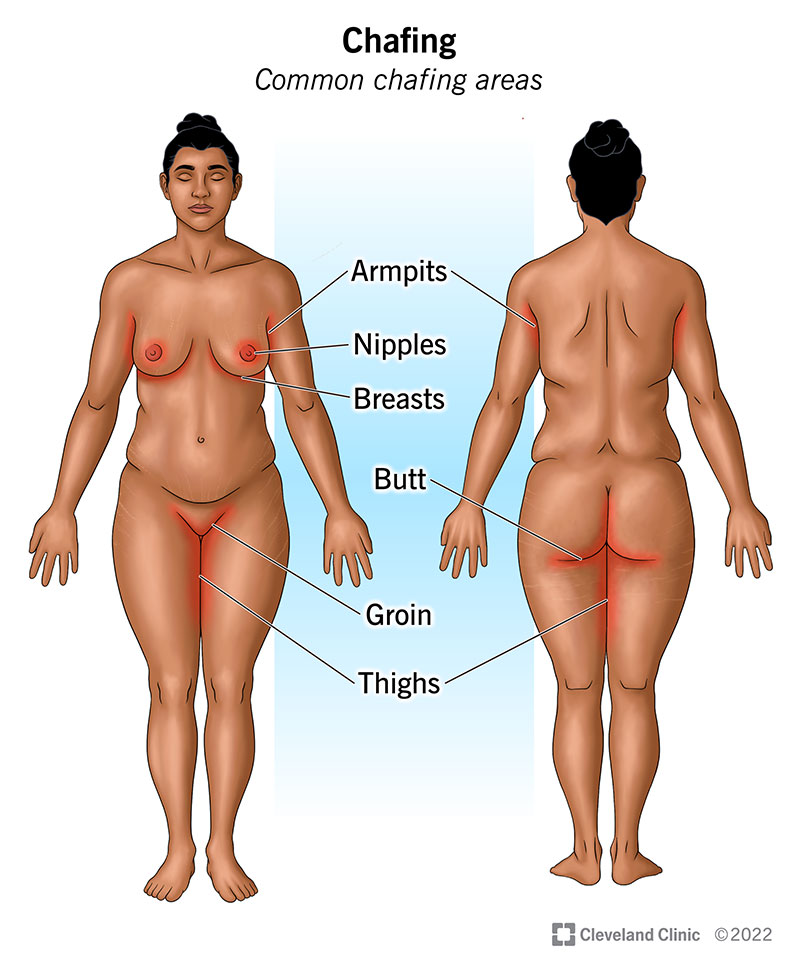Chafing happens when something rubs enough to wear away and damage your skin. It’s common, but usually nothing more than an annoyance. This common condition happens for all kinds of reasons, and it’s usually nothing to worry about. With the right care, it clears up quickly. And there’s plenty you can do to keep it from happening in the first place.
Advertisement
Cleveland Clinic is a non-profit academic medical center. Advertising on our site helps support our mission. We do not endorse non-Cleveland Clinic products or services. Policy

Chafing is skin irritation from your skin rubbing against something else. It commonly happens around places where skin rubs against other skin. That’s especially true with sensitive skin or places that are warm and moist. That includes your inner thighs, groin, buttocks, armpits and chest. And it can happen when your clothing or surfaces rub against your skin.
Advertisement
Cleveland Clinic is a non-profit academic medical center. Advertising on our site helps support our mission. We do not endorse non-Cleveland Clinic products or services. Policy
Some common types of chafing you can have on your body are:
The more rubbing that happens, the worse chafing usually gets. And if there’s moisture there, chafing can cause issues that need medical care.
The milder symptoms of chafing can include:
Advertisement
As chafing gets worse, it can cause more serious symptoms, like:
Friction is always the root cause of chafing. There’s only so much friction your skin can take. And the more your skin rubs against something — especially rougher things — the more likely chafing becomes.
Moisture can make chafing much worse. It makes it easier for materials and surfaces to slip and rub against your skin. Moisture also makes your skin easier to damage.
Some other things that can cause or contribute to chafing include:
Chafing is more likely to cause complications when it lasts a long time and/or is severe. Some of the most likely complications include:
Minor chafing is something you can recognize on your own. You don’t need to see a healthcare provider for it.
But when chafing is longer-lasting or severe, you should see a healthcare provider. They can diagnose chafing by looking at the affected area and asking questions about your recent activities.
If your provider suspects a skin infection, they might recommend taking a scraping sample. They’ll use the edge of a scalpel to gently scrape across the surface of your skin. That lets them collect skin cells they can test for bacteria or fungi. These tests can help your provider pick the best infection treatment.
Advertisement
You can self-treat minor chafing. That starts with stopping whatever’s causing or contributing to it. Some things you can do include:
If your chafing is severe enough to need medical care, treatment might include:
Your healthcare provider may also tell you how to keep the affected areas clean, like showering or using certain kinds of antiperspirants. These can help your skin recover and prevent chafing from coming back. Your provider can answer any questions and tell you more about how and why these help.
Advertisement
Minor chafing usually clears up within a few days. If it takes longer, you should talk to a healthcare provider.
If you have a more serious case that needs medical treatment, it might take longer to heal. Your healthcare provider can tell you what to expect.
You should call your healthcare provider if chafing symptoms don’t get better within a few days or get worse. That includes cases that you self-treat and those you got medical care for.
Chafing can be annoying, uncomfortable or painful. But it usually isn’t serious. With the right care, it should clear up on its own. And many of the things you do to self-treat chafing will also keep it from happening again.
To prevent chafing, you can:
Advertisement
Chafing and jock itch can affect the same area, but they have different causes. Chafing happens because of friction, and it doesn’t spread to others. Jock itch is a fungal skin infection, and it’s very contagious.
But while they’re different, having chafing damages your skin. That can make it easier to get jock itch or other infections. And if you have jock itch and scratch yourself, it can lead to chafing. So, it’s possible to get these conditions back-to-back.
Maybe it’s a blister from a new pair of shoes. Or you got a new swimsuit and your skin isn’t happy about it. Chafing happens when something literally rubs you the wrong way. But fortunately, it’s usually not serious, and you can treat it yourself. But if you have questions about chafing, talk to your healthcare provider. They can help if you have chafing that won’t go away and guide you on how to keep it from happening again.
Cleveland Clinic’s primary care providers offer lifelong medical care. From sinus infections and high blood pressure to preventive screening, we’re here for you.

Last reviewed on 08/25/2025.
Learn more about the Health Library and our editorial process.